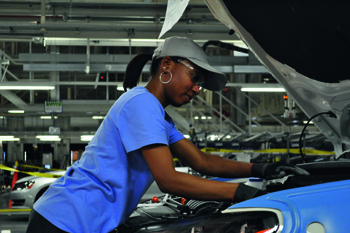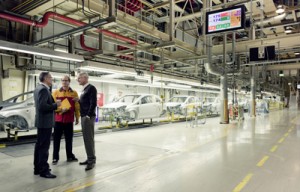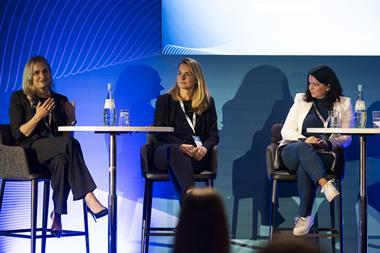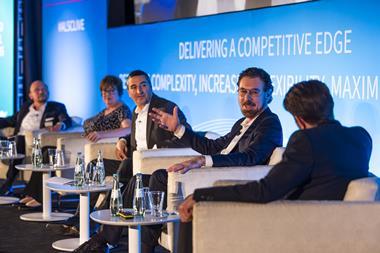Recalls and a carmaker's ability to carry them out efficiently can have an effect not just on public relations, but on the company’s bottom line and share price. LSPs are increasingly getting involved.

Volkswagen had issued a recall notice for a number of turbocharged vehicles sharing a particular automatic transmission, including the company’s best-selling Jetta, Passat and Beetle models. A couple of ‘O’-rings on each transmission’s oil cooler were too small, which could cause oil to leak out, leading the transmission to overheat and ultimately fail.
“It wasn’t a call that any dealer wants to get,” he explains, but better news was around the corner. After limping through Thursday afternoon, Friday and Saturday, a batch of ‘O’-rings arrived the following Monday.
“It took between an hour and an hour-and-a-half to fix each car,” recalls Cockerham, “but the result was that we went from having a lot full of cars that couldn’t be sold, to a lot full of cars that could be sold. It was the recall process as it should be – slick and efficient, just as you want it.”
Even as Volkswagen was alerting its customers and shipping replacement ‘O’-rings to dealers like Cockerham all over North America, General Motors was under public scrutiny for presiding over a high-profile recall process that appeared to be anything but slick and efficient.
Some 2.6m cars were recalled due to a faulty ignition switch – a problem that turned out to have been known about for a decade, involving a design that didn’t even meet GM’s own internal standards for ignition switches. The design flaw was not trivial, with independent studies saying it resulted in a high number of deaths and accidents. New GM chief executive Mary Barra was called before Congress to explain.
Beside the reputational damage done to the GM brand, the recall hit the company’s first-quarter profits with a hefty $1.3 billion charge against earnings, to cover the huge costs involved in recalling so many cars. Included was no less than $300m to cover the cost of providing courtesy cars to customers while their own vehicles were being repaired.
These were very different recalls in scope and outcome, but their lessons apply across the industry. Already the fallout from GM’s recall, as well as Toyota’s massive issue several years earlier, is that carmakers are opting to pay for repairs and replacements rather than face legal costs and penalties. With a rise in recalls also comes pressure on logistics experts and providers to help make them as efficient and painless as possible for customers, dealers and OEMs. A number of providers, such as DHL and Ryder, have taken on a considerable amount of third-party work, including managing administration and distribution operations of a recall.

Recalls reverberate across the supply chain; replacements must be manufactured and shipped to national aftermarket distribution operations, while locating and contacting a vehicle’s current owner can often result in a significant number of vehicles being left unmodified.
On the manufacturing side, there are issues over supplier capacity, which is still tight in the wake of the recession, but room simply must be found in production schedules to manufacture high volumes of the replacement parts demanded by recalls – and quickly.
“It all depends on tooling,” says Stephan Friechel, a former ZF and General Motors executive, now an independent consultant at Cologne’s University of Applied Sciences. “If a tool can only produce 10,000 parts a week, then that’s the practical limit. It’s not that a second tool can’t be made, it’s the time taken to manufacture it and ramp up production.”
After which, he notes, there’s the question of ancillary demand for associated parts, such as seals, washers, bearings or new screws, for instance, thereby becoming a ‘recall kit’.
“In practice, a major point is the non-availability of sufficient quantity and capacity to produce the correct parts once the field fix is defined,” he concludes. “Field fixes may need to pull product from several supply chains to bring together the relevant modules, fitting instructions, packaging, tools, ‘thank-you gifts’ and loan cars – which all have to come together at a single point in order to deliver customer satisfaction and a high quality repair.”
Retail versus fleet
Consumers are also likely to have very different needs during recalls. A retail customer may positively value a recall letter from a dealer, or the carmaker, seeing it as a value-adding form of aftersales service. The relevant work on the vehicle can be done at a time to suit the customer and a loan car made available if the repair is a lengthy one.
A fleet operator, however, will want contacting just once (rather than once for each affected vehicle that they own) and will see the recall as a potential loss of revenue. In the case of fleet vehicles kitted out with specialist equipment for particular purposes, the offer of a loan vehicle may be meaningless.
“A vehicle recall is hassle for any business, but for those operating multiple vehicles it can be hugely disruptive,” says Jonathan Pearce, head of marketing at 62,000-vehicle fleet operator Northgate Vehicle Hire and its sister company, Van Monster. “Recalls come out of the blue and your vehicles will be dispersed across a wide geographic area, and tied in with customer jobs or contracts. If your vehicles are operating across the entire country you will have to deal with multiple dealers to organise the repairs, all with different service levels and lead times.”
Delicate distribution
Also to be taken into account is managing the flow of recall parts from the supplier’s factory to the dealers who will fit them. It’s a process that requires a fine balance between the supply chain’s ability to manufacture and ship the parts, and the physical ability of dealers to store and fit them.
Get the balance wrong and scarce replacement parts could end up sitting on dealers’ shelves while other dealers’ customers drive vehicles that may be prone to failure. Also – especially in the case of large parts, or those which are time-consuming to fit – there’s a danger that the flow of parts may exceed a dealer’s ability to store and fit them.[sam_ad id=6 codes='true']
Experts say the problem is set to worsen. As globalisation and platform consolidation combine to lengthen the industry’s supply chains, its products are becoming more complex. A premium-class car can contain 100m lines of software code distributed among its various components – more than modern-era passenger and combat jets such as Boeing’s 787 and the F35 Joint Strike Fighter.
Ready with a plan
Recalls are truly an automotive industry-wide issue; every brand has to deal with them at some point and the entire industry is becoming increasingly aware of the reputational upside of handling them smoothly.

As an example of effective recall management, Strong points to BMW’s 2012 recall of 1.3m vehicles which resulted from potentially defective battery cable covers. “After only nine reports of the defect in question, BMW issued a recall and found that only 1% of vehicles tested suffered from the incorrect cable covering. Clearly, BMW was taking a precautionary stance, but the resulting public relations impact was excellent,” she observes. “Posts on internet forums openly raved about the general quality of service and pointed to the recall as just another element of that first-class service.”
One way to turn a recall into an advantage, says Bruce Arlinghaus, an independent global supply chain consultant, is to take a leaf out of the aviation industry’s playbook, where regulations mandate that airlines and aircraft manufacturers have in place disaster-preparedness plans.
“The airlines and aircraft manufacturers go through this with surprising regularity and know that they must plan for it, in order to stop a bad situation from getting any worse,” he says. “If you look at cases such as GM’s ignition switch recall, or Toyota’s unintended acceleration recall in 2009 and 2010, they didn’t do that [planning]: they shot the messenger and went into denial about what was happening.”
It ought to be easier for the automotive industry to adopt such plans, says Arlinghaus, especially since its recalls tend to develop more slowly than in aviation. “The industry needs to stop benchmarking itself against other auto manufacturers and start looking at industries like aviation.”
Nicky Strong agrees, stressing that effective recall policies need to be agreed and monitored at board level, clearly mandating at what point a recall is triggered; the respective roles played by regulatory authorities and the carmaker’s own decision-making body; and which parts of the business must be involved in the operational planning and execution – including logistics – that underpin an effective recall.

A clue to the slick experience that Bob Cockerham’s car dealership had during its recent recall may lie in the fact that Volkswagen does indeed have a very formalised process for dealing with recalls. “You have to start by getting all the relevant stakeholders together, around a table,” says Jan Bures, executive vice-president of group aftersales and service at Volkswagen Group of America.
“This, of course, first requires a process being in place which tells you who these stakeholders are. Then you start work: what is the problem? What might be the solution? How and where are the required parts to be sourced, and how is the recall notification going to be published?”
The group of stakeholders is extensive, he adds. Publishing any information, for instance, requires specialists with regulatory sign-off expertise to ensure compliance. Customer relationship management specialists are also required to identify affected consumers. Documentation specialists must then ensure that any knowledge learned is appropriately codified and retained. Technical and quality people must then sign-off on the required solution, and purchasing people must find a way of dealing with the resulting spike in demand – including dual sourcing parts, if necessary. Finally, logistics specialists must begin the process of getting the relevant parts to dealers.
It’s here, says Bures, that some of the greatest challenges lie. “You start by knowing to which dealers the population of vehicles originally went in the first place,” he explains, “but then you need to find out if subsequent ‘inter-dealer’ trades were done. Only at that point can you very roughly allocate parts to dealers – and if you don’t have enough to meet the requirement in full, then you send some. With fleets, though, the vehicles could be almost anywhere, so we tend to advise fleet owners to contact the nearest applicable dealer.”
Affected parts might well have their own, independent demand, arising from normal wear and tear during vehicle operation. This calls for careful management of inventory allocation, explains Bures.
“Dealers also stock inventory, of course, and we must constrain dealer stock replenishment orders if we need the parts for a recall,” he says. “So in those cases, we combine a part number with an associated VIN, in order to ensure that remediation is given priority over dealer inventory stocking.”
Very occasionally, he adds, recall part flows need to bypass the dealer network altogether. In 2000, for instance, when the retrofitting of a rear spoiler to the Audi TT sports car was mandated on safety grounds, the job was deemed inappropriate for the dealer network to carry out. Instead, says Bures, the job was handed to logistics facilities operated by third-party providers, using trained mechanics. Parts would be shipped to the logistics sites, while vehicles were picked up from dealer premises and transported to the facilities for the fitting operation, before being returned.

The Audi example demonstrates there is clearly a role for 3PLs in recalls. These events cause sudden demand that can overload existing networks, require tight time deadlines and bypass existing parts flow networks altogether. Using an outsourcing expert can be an effective way to manage such challenges.
ExpertSOLUTIONS, a division of hazardous waste management company Stericycle, has been handling automotive recalls in many countries for 24 years. The 14 OEMs for whom the firm acts include Toyota, Lexus, Honda, Suzuki and Harley-Davidson, says client services director Barry Nielsen.
With its own parts handling warehouses and contact centres covering 35 countries and 21 languages, the firm handles notifications to dealers, consumers and fleet managers, and can also, if required, handle the reverse logistics flow, securely and safely disposing of the waste stream of parts and associated fluids in an environmentally responsible manner.
ExpertSOLUTIONS’ recall-handling processes have been used by the UK government’s Vehicle and Operator Services Agency as an example of industry best practice, based on as many as 1.2m vehicle recalls in a 12-month period.
“In general, a ‘typical’ recall campaign takes around 18 months,” he notes. “It takes time to get the contact data together and to cleanse it, but often the biggest delay is parts availability. We contact the customer, tell them how their vehicle is affected and advise them as to where and when they need to take their vehicle to be repaired.”
Recalls involving fleets, he explains, are an area of particular expertise. The company has developed a process whereby it creates a real-time recall ‘microsite’ that all of the relevant contacts use, eliminating the need for thousands of letters. The microsite not only provides access to both carmakers and fleet managers – so both can verify the progress of a given recall – but is capable of handling multiple recalls at once.
“A fleet can be working across multiple manufacturers and multiple individual recalls, and we provide ‘one-stop’ visibility, telling the fleet manager exactly where they are in terms of a recall’s progress,” says Nielsen.
Logistics service providers are also coming forward with their own recall solutions. DHL, for instance, explicitly links its decision to enter the market with its involvement in several recent large-scale recalls. “We noticed that we were being called in quite late in the process and asked to ship parts to dealers in a hurry, which highlighted some of the issues that were involved in recalls,” says Fathi Tlatli, president of the automotive sector within DHL’s Customer Solutions and Innovation division. “We found that dealers didn’t always have the capacity to store parts, or that parts were delivered too late – or too early – and that customers weren’t always informed about the recall, and the associated need to replace the parts in question.”
In each case – from DHL’s storage capacity to its distribution capability and from its call centres to its project management skills – there seemed to be an overlap between the problem involved and DHL’s abilities. The company decided to launch a more proactive service.
“It can take three months to set up for a specific recall and 6-9 months to execute it,” Tlatli explains. “Having a service already set up cuts the three-month delay down to one month and permits the execution phase to start sooner, and probably be finished more quickly as well.”

Tom Kroswek, senior director for supply chain excellence in the automotive group at Ryder System, agrees. Shared platforms, global models and growing component commonality are all tending to increase the size of the typical recall, he notes, with Ryder currently working on several recalls involving more than 1m vehicles.
“Typically, we’re increasingly being asked to design the distribution methodology, price it and then operate it,” says Kroswek. “It’s about picking up from the tier one manufacturer and delivering to the dealerships – analysing the product flow path, figuring out if it will fit within the normal flow, and formulating a plan of action.
“The automotive industry is doing a lot more planning around recalls than used to be the case and as an industry, it’s getting better at performing recalls. We don’t think that the two are unconnected.”





















